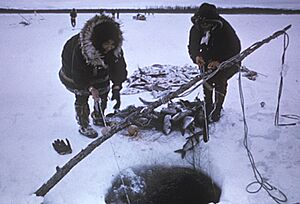Nelma facts for kids
Quick facts for kids Stenodus nelma |
|
|---|---|
 |
|
| Conservation status | |
| Scientific classification | |
| Synonyms | |
|
The nelma (also called sheefish or inconnu) is a type of freshwater whitefish. It belongs to the Salmonidae family, which also includes salmon and trout. This fish is important for fishing and is found in many cold rivers.
You can find nelma across the Arctic regions. They live in rivers from the Kola Peninsula in Russia, all the way across Siberia to the Anadyr River. They are also found in North America, in the Yukon River and Mackenzie River basins.
What the Nelma Looks Like
The nelma is a large fish. It can grow up to 150 centimetres (59 in) long. That's about 5 feet! An adult nelma can weigh up to 27 kilograms (60 lb), which is around 60 pounds.
This fish has a big mouth. Its lower jaw sticks out a bit. It also has a tall, pointed fin on its back called a dorsal fin. Nelma are usually silver. Their backs might have hints of green, blue, or brown. Their meat is white, flaky, and a little bit oily.
Where Nelma Live and What They Eat
Nelma live in both lakes and rivers. They can also be found in brackish water. This is water that is a mix of fresh and salty water, usually where rivers meet the ocean.
When nelma are very young, they eat tiny living things called plankton. After their first year, they become predators. This means they hunt and eat smaller fish.
Many nelma are anadromous fish. This means they live in both fresh and saltwater. They are born in fresh water, travel to the ocean or brackish water to grow, and then return to fresh water to lay their eggs. Some nelma populations travel very far to lay their eggs. They can migrate more than 1,600 kilometres (1,000 mi) upriver! However, some groups of nelma stay in fresh water their whole lives and do not migrate to the ocean.
Nelma and Other Fish
Scientists used to think the nelma was a type of Stenodus leucichthys. That fish is called the beloribitsa. The beloribitsa lived only in the Caspian Sea area. Sadly, the beloribitsa is now extinct in the wild, meaning it no longer exists outside of human care. But now, scientists know that the nelma is its own unique species.



